- Home
- Features
- Business
- Active
- Sports
- Shop
Top Insights
How to Find the Right White Label Wallet for Your Web3 Gaming Platform in 2025?

Essential Tips for Choosing the Best Wallet Solution to Elevate Your Web3 Gaming Experience.
As the Web3 gaming landscape continues to evolve, selecting the right white label wallet is crucial for your platform’s success in 2025. A well-integrated wallet enhances user experience, ensuring seamless transactions and robust security. With various options available, it’s essential to evaluate your specific needs, such as scalability, compatibility with different cryptocurrencies, and the ability to provide advanced features like in-game purchases and decentralized finance (DeFi) functionalities. User-friendly interfaces and customizable branding are also vital to engage players and foster loyalty.
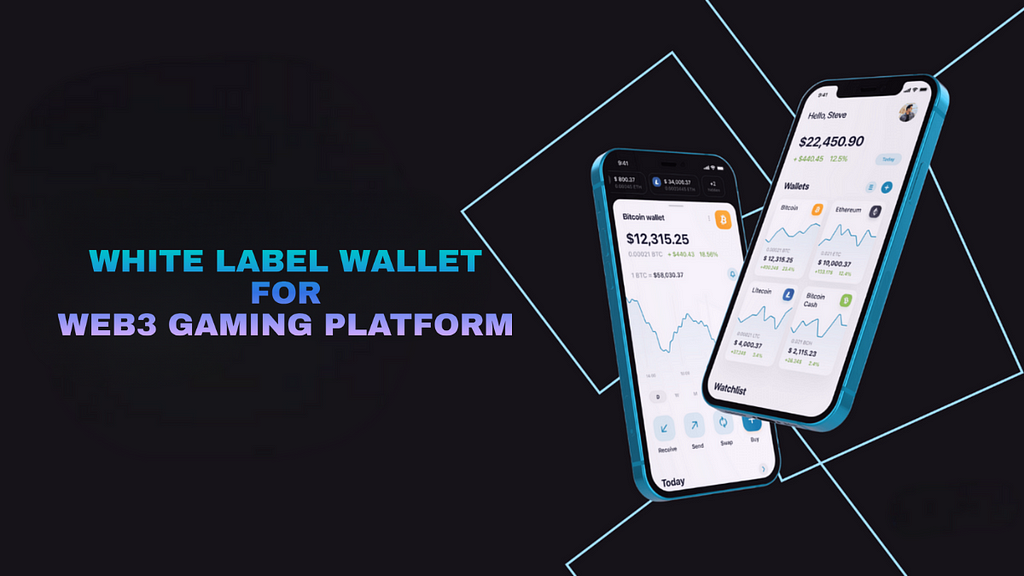
Additionally, consider the wallet’s security measures, including multi-signature support and compliance with regulatory standards, to protect user assets and data. As you navigate this complex landscape, prioritize partnerships with reputable providers that offer reliable support and regular updates to stay ahead of emerging threats. By making informed decisions about your white label wallet, you can create a secure and engaging gaming environment that attracts and retains players, ultimately driving your platform’s growth in the competitive Web3 space.
Table of Content
Understanding White Label Wallets
Critical Factors in Crypto Wallet Gaming Platform Development
How to Select a White Label Crypto Platform For Owner’s?
Best Web3 White Label Crypto Wallet Recommendations for Gaming Developers
Evaluating Cost and Pricing Models
Future Advancements to Expect in Web3 White Label Gaming Platform
Conclusion
Understanding White Label Wallets
White label wallets are customizable digital wallet solutions that allow businesses to offer secure cryptocurrency and asset management services under their own brand. Designed to streamline the integration process, these wallets provide a ready-made infrastructure that can be tailored to meet specific user needs and preferences. Companies can leverage white label wallets to enhance user experience by offering features such as multi-currency support, seamless transactions, and robust security measures.
By adopting a white label solution, businesses can save time and resources on development while focusing on their core competencies, such as marketing and customer engagement. This approach not only accelerates the launch of new services but also helps maintain brand consistency in the rapidly evolving landscape of digital finance and Web3 applications.
Critical Factors in Crypto Wallet Gaming Platform Development
Developing a crypto wallet gaming platform involves several critical factors that ensure its success, security, and usability. Here are some key considerations:
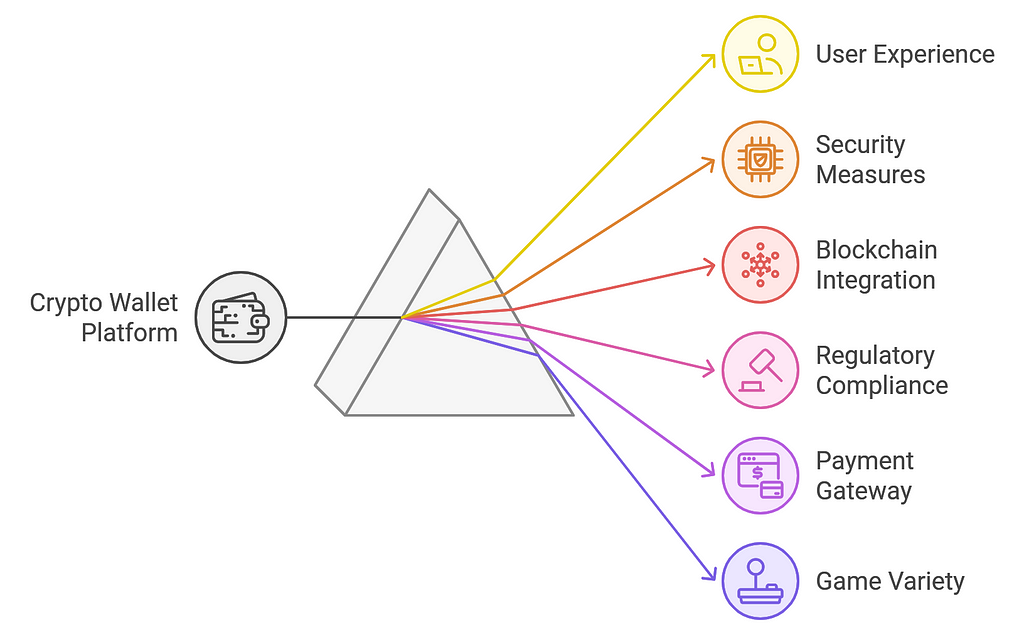
1. User Experience (UX) and Interface Design
- Intuitive Navigation: Create a seamless and user-friendly interface that makes it easy for users to navigate the platform.
- Responsive Design: Ensure that the platform is optimized for various devices, including desktops, tablets, and smartphones.
- Onboarding Process: Provide a simple onboarding process for new users, including tutorials on using crypto wallets and gaming functionalities.
2. Security Measures
- Encryption: Use strong encryption protocols to protect user data and transactions.
- Two-Factor Authentication (2FA): Implement 2FA to enhance account security.
- Smart Contract Audits: Regularly audit smart contracts for vulnerabilities to prevent hacks and exploits.
- Cold Wallet Storage: Store the majority of funds in cold wallets to minimize risks associated with online storage.
3. Blockchain Integration
- Choose the Right Blockchain: Select a blockchain that aligns with your platform’s goals (e.g., Ethereum for smart contracts, Binance Smart Chain for lower fees).
- Interoperability: Consider cross-chain compatibility to allow users to interact with multiple cryptocurrencies.
4. Regulatory Compliance
- Legal Considerations: Understand and comply with the regulatory landscape in the jurisdictions where you operate.
- KYC/AML Policies: Implement Know Your Customer (KYC) and Anti-Money Laundering (AML) measures to meet legal requirements.
5. Payment Gateway Integration
- Multiple Cryptocurrency Support: Allow users to deposit and withdraw various cryptocurrencies to attract a broader audience.
- Fiat On-Ramp Solutions: Provide options for users to purchase cryptocurrencies with fiat currencies easily.
6. Game Development and Variety
- Diverse Game Offerings: Develop a range of games (e.g., skill-based, chance-based, multiplayer) to cater to different user preferences.
- Fairness and Transparency: Ensure that games use provably fair algorithms, allowing users to verify the fairness of outcomes.
7. Community Engagement
- Incorporate Social Features: Enable players to interact, compete, and share experiences to build a vibrant community.
- Feedback Mechanism: Implement channels for users to provide feedback and suggestions for improvement.
8. Marketing and User Acquisition
- Targeted Marketing Strategies: Utilize social media, influencer partnerships, and crypto forums to reach potential users.
- Referral Programs: Offer incentives for users to refer friends and expand the user base.
9. Scalability and Performance
- Load Testing: Conduct thorough load testing to ensure the platform can handle high traffic and transactions.
- Optimized Performance: Continuously monitor and optimize platform performance to reduce latency and enhance user satisfaction.
10. Continuous Development and Updates
- Regular Updates: Keep the platform up to date with the latest security patches, features, and user-requested improvements.
- Adapt to Market Trends: Stay informed about industry trends and user preferences to evolve the platform accordingly.
By focusing on these critical factors, developers can create a robust and successful crypto wallet gaming platform that attracts and retains users while ensuring security and compliance.
How to Select a White Label Crypto Platform For Owner’s?
Selecting a white-label crypto platform is a crucial decision for business owners looking to launch a cryptocurrency-related service. Here’s a comprehensive guide on how to choose the right platform:
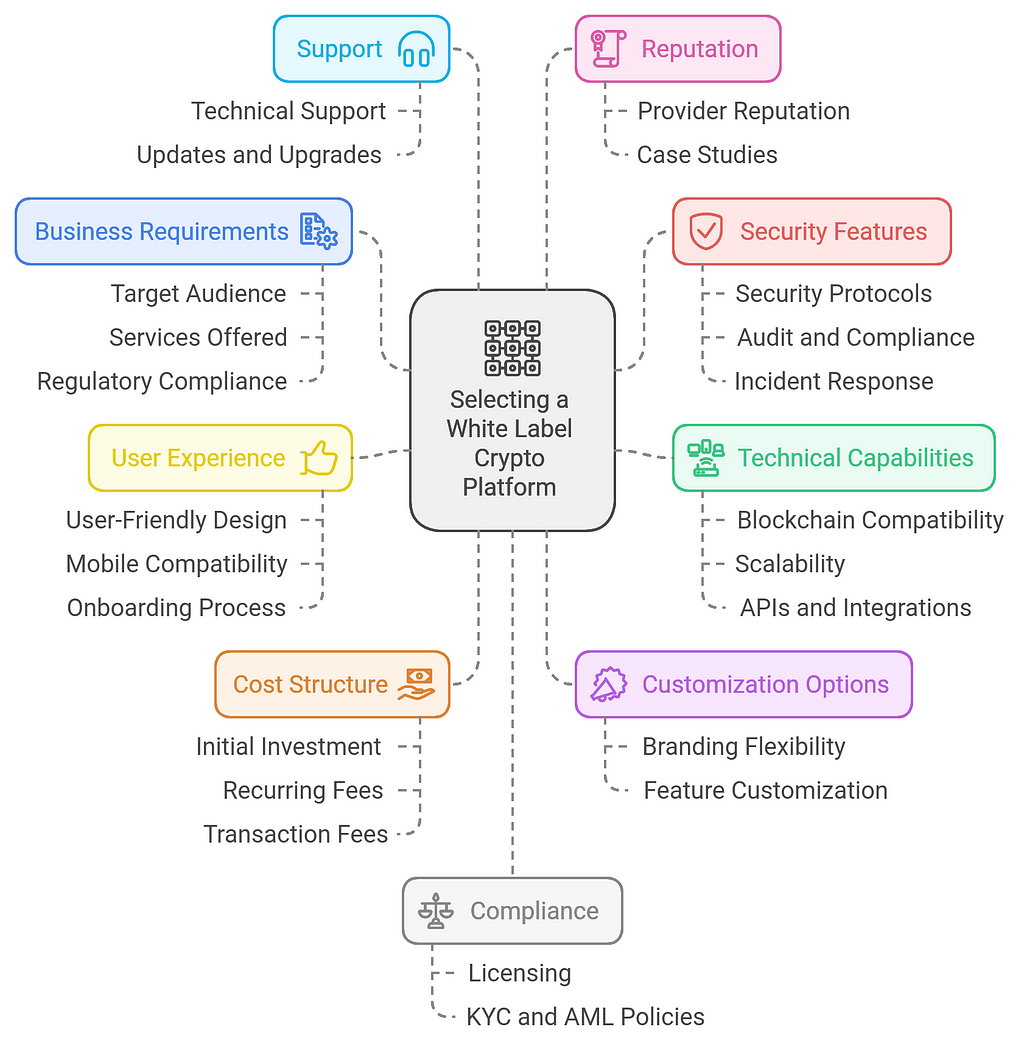
1. Define Your Business Requirements
- Target Audience: Identify who your primary users will be (traders, gamers, investors).
- Services Offered: Determine what services you want to provide (exchanges, wallets, staking, lending).
- Regulatory Compliance: Consider the legal requirements in your target regions.
2. Evaluate Security Features
- Security Protocols: Look for platforms with strong encryption, secure private key management, and two-factor authentication (2FA).
- Audit and Compliance: Ensure that the platform has undergone third-party audits and complies with industry standards (e.g., ISO/IEC 27001).
- Incident Response: Check for a clear incident response plan in case of breaches.
3. Assess Technical Capabilities
- Blockchain Compatibility: Ensure the platform supports the specific blockchains and tokens relevant to your business model.
- Scalability: Look for platforms that can scale with your user base and transaction volume.
- APIs and Integrations: Verify the availability of APIs for third-party integrations and ease of connecting with existing systems.
4. User Experience (UX) and Interface
- User-Friendly Design: The platform should have an intuitive interface that enhances user experience.
- Mobile Compatibility: Ensure the platform is optimized for mobile devices if you plan to reach a mobile audience.
- Onboarding Process: A smooth onboarding process can significantly enhance user retention.
5. Customization and Branding Options
- Branding Flexibility: Check if the platform allows for customization of logos, color schemes, and features to align with your brand identity.
- Feature Customization: Assess how much flexibility you have in adding or modifying features.
6. Cost and Pricing Structure
- Initial Investment: Analyze the upfront costs involved in acquiring the platform.
- Recurring Fees: Consider any ongoing fees for maintenance, updates, and support.
- Transaction Fees: Understand the fee structure for transactions and how it impacts your revenue model.
7. Support and Maintenance
- Technical Support: Look for platforms that offer 24/7 technical support to assist with any issues that may arise.
- Updates and Upgrades: Ensure the provider regularly updates the platform to keep up with market trends and security measures.
8. Reputation and Reviews
- Provider Reputation: Research the provider’s reputation in the industry and check for user reviews and testimonials.
- Case Studies: Ask for case studies or examples of successful implementations by other businesses.
9. Compliance and Legal Considerations
- Licensing: Ensure that the platform adheres to necessary licensing and regulatory requirements in your operating regions.
- KYC and AML Policies: Confirm that the platform has robust Know Your Customer (KYC) and Anti-Money Laundering (AML) measures in place.
10. Trial and Demonstration
- Demo Access: Request a demo or trial version of the platform to evaluate its functionality and user experience.
- Test Environment: If available, explore a sandbox environment to assess integration capabilities and performance.
Selecting the right white-label crypto platform involves a thorough assessment of your business needs, technical requirements, and user experience. By taking the time to evaluate various options based on the factors mentioned above, business owners can make informed decisions that align with their goals and ensure a successful launch in the crypto space.
Best Web3 White Label Crypto Wallet Recommendations for Gaming Developers
Choosing a suitable Web3 white-label crypto wallet is crucial for gaming developers looking to integrate cryptocurrency functionalities into their platforms. Here are some of the best options that provide robust features, security, and flexibility:
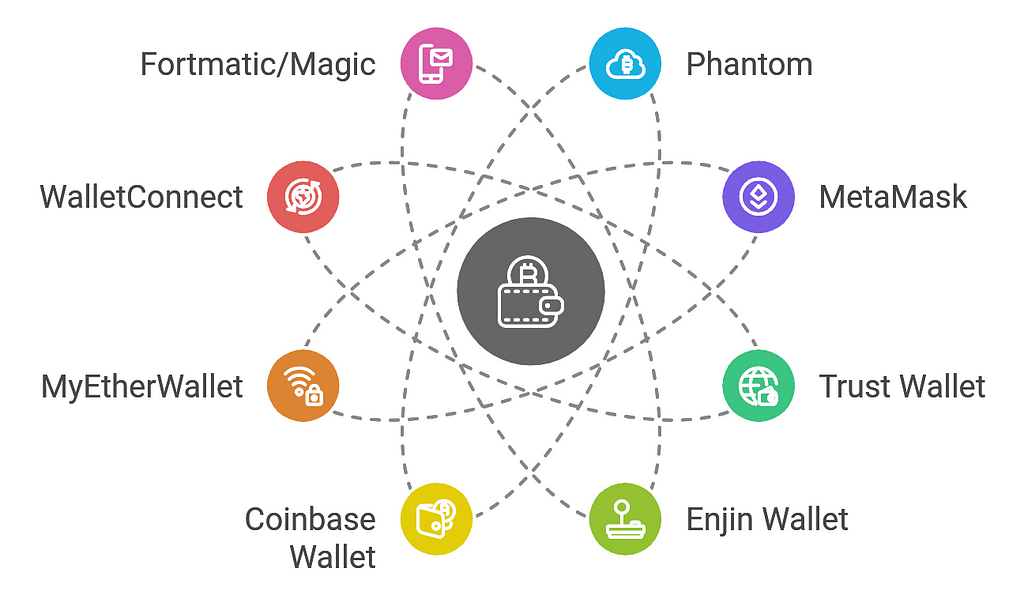
1. Phantom
- Overview: Initially developed for Solana, Phantom is now expanding its offerings to support various blockchains.
- Key Features: User-friendly interface, NFT support, built-in DApp browser, and seamless integration with gaming applications.
- Best For: Developers focusing on Solana-based games.
2. MetaMask
- Overview: One of the most popular Ethereum wallets, MetaMask allows users to interact with decentralized applications.
- Key Features: Browser extension and mobile app, support for Ethereum and ERC-20 tokens, and easy integration with DApps.
- Best For: Games built on Ethereum and compatible networks.
3. Trust Wallet
- Overview: An official wallet of Binance, Trust Wallet supports multiple blockchains and a wide variety of tokens.
- Key Features: In-built DApp browser, staking capabilities, and NFT support.
- Best For: Developers looking for a versatile wallet that supports a wide range of cryptocurrencies.
4. Enjin Wallet
- Overview: Enjin Wallet is designed specifically for gaming, allowing users to manage their crypto assets and NFTs efficiently.
- Key Features: Multi-chain support, NFT management, and integration with Enjin’s gaming ecosystem.
- Best For: Game developers focusing on NFT integration and the gaming community.
5. Coinbase Wallet
- Overview: A user-friendly wallet from Coinbase that allows users to store and manage their crypto assets.
- Key Features: Supports a wide range of cryptocurrencies, integrated with Coinbase services, and an easy onboarding process.
- Best For: Developers who want to leverage the Coinbase ecosystem for user acquisition.
6. MyEtherWallet (MEW)
- Overview: A popular Ethereum wallet that provides a robust interface for managing ERC-20 tokens.
- Key Features: Open-source, user-controlled private keys, and integration with hardware wallets.
- Best For: Ethereum-based games that prioritize security and user control.
7. WalletConnect
- Overview: While not a wallet itself, WalletConnect acts as a bridge allowing users to connect their wallets to DApps securely.
- Key Features: Supports multiple wallets, easy integration with DApps, and strong security features.
- Best For: Developers who want to support various wallets without building their own.
8. Fortmatic/Magic
- Overview: A user-friendly wallet that allows users to sign in using their email or phone number.
- Key Features: Seamless onboarding, multi-chain support, and easy integration into gaming applications.
- Best For: Developers targeting non-technical users who may be new to crypto.
9. Gnosis Safe
- Overview: A multi-signature wallet designed for secure asset management, making it suitable for team-based projects.
- Key Features: Multi-signature capabilities, support for NFTs, and integration with DeFi protocols.
- Best For: Development teams managing funds collectively.
10. Zebpay Wallet
- Overview: Zebpay offers a secure wallet with a focus on user experience and regulatory compliance.
- Key Features: Multi-currency support, robust security measures, and an integrated exchange.
- Best For: Developers focusing on regions where Zebpay has a strong presence.
By selecting the right white-label crypto wallet, gaming developers can enhance user experience and provide secure, efficient access to cryptocurrency features within their games.
Evaluating Cost and Pricing Models
When considering a white-label wallet for your Web3 gaming platform in 2025, evaluating cost and pricing models is crucial for ensuring sustainability and profitability. Here’s a structured approach to finding the right wallet, including expected cost ranges and timelines for development and integration.

1. Identify Your Requirements
- Functionality Needs: Define the essential features (e.g., multi-currency support, NFT integration, staking).
- User Experience: Determine the importance of an intuitive UI and UX for onboarding users.
2. Research and Compare Providers
- Market Analysis: Investigate various white-label wallet providers, their offerings, and client reviews.
- Feature Comparison: Create a comparison chart of providers based on features, security, and customization options.
3. Cost Structure Evaluation
- Initial Licensing Fees: Expect initial setup costs typically ranging from $15,000 to $50,000 depending on the provider and the complexity of the wallet.
- Customization Costs: If extensive customization is needed, this can add an additional $5,000 to $30,000. Custom branding, UI modifications, and additional feature development can influence this cost.
- Integration Fees: Integrating the wallet with your gaming platform may incur costs ranging from $5,000 to $20,000 based on the platform’s architecture and the wallet’s API documentation.
4. Ongoing Costs
- Maintenance and Support: Monthly support and maintenance fees usually fall between $500 to $2,000. This includes technical support, updates, and security audits.
- Transaction Fees: Depending on the provider, transaction fees could range from 0.5% to 2% per transaction, which should be factored into your financial model.
5. Revenue Model Considerations
- Service Fees: Consider charging users a small service fee on transactions, which can help cover ongoing costs.
- In-App Purchases: If your wallet integrates with your gaming platform, explore additional revenue opportunities through in-game purchases or premium wallet features.
6. Duration for Implementation
- Selection Process: Budget approximately 1 to 2 months to evaluate and select a white-label wallet provider, including meetings and demos.
- Customization and Development: The development and customization phase may take 2 to 4 months based on complexity and feature requirements.
- Integration and Testing: Allocate another 1 to 2 months for integration with your gaming platform and extensive testing to ensure seamless functionality and security.
7. Total Cost and Timeline Summary

In 2025, selecting the right white-label wallet for your Web3 gaming platform involves careful evaluation of costs and the expected duration for development and integration. By understanding the financial implications and timelines associated with different wallet providers, you can make an informed decision that aligns with your budget and strategic goals. This approach ensures a smooth implementation, allowing you to focus on delivering an engaging gaming experience to your users.
Future Advancements to Expect in Web3 White Label Gaming Platform
As Web3 technology continues to evolve, gaming platforms built on this framework are likely to see significant advancements. Here are some future developments to expect in Web3 white-label gaming platforms:
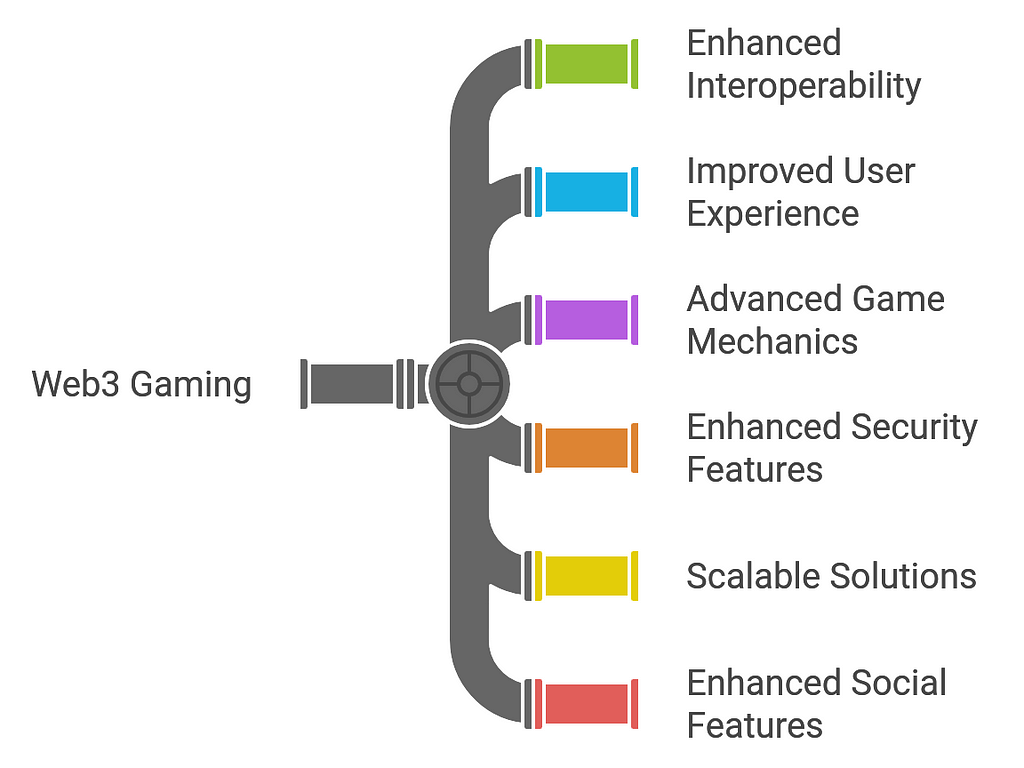
1. Enhanced Interoperability
- Cross-Game Asset Transfer: Players will increasingly be able to transfer assets between different games, thanks to standardized protocols and blockchain technology.
- Multi-Chain Support: Future platforms may seamlessly integrate multiple blockchains, allowing developers to choose the best options for their games.
2. Improved User Experience
- Streamlined Onboarding: Simplified user interfaces and onboarding processes will reduce barriers for non-crypto-savvy users, allowing easier access to Web3 gaming.
- Wallet Integration: Advanced wallet solutions will enable users to connect their wallets more easily, enhancing the user experience without compromising security.
3. Advanced Game Mechanics
- Dynamic NFTs: Non-Fungible Tokens (NFTs) that can evolve based on gameplay, ownership, or external factors will create deeper engagement and new monetization strategies.
- Decentralized Autonomous Organizations (DAOs): Game communities may govern game updates, development, and economies through DAOs, giving players a real stake in the game.
4. Enhanced Security Features
- Multi-Signature Wallets: Enhanced security measures will become standard, with multi-signature wallets for asset management and transactions to prevent unauthorized access.
- Robust Anti-Cheat Mechanisms: Integration of blockchain’s transparency will aid in developing cheat-proof systems, ensuring fair play.
5. Scalable Solutions
- Layer 2 Solutions: Adoption of Layer 2 solutions like rollups or sidechains will significantly increase transaction speeds and reduce costs, allowing for smoother gameplay experiences.
- Cloud Gaming: Integration with cloud gaming platforms will allow players to experience high-quality graphics and gameplay without needing powerful hardware.
6. Enhanced Social Features
- In-Game Communities: Platforms will increasingly support social features such as guilds, forums, and chat functionalities to enhance community engagement.
- Content Creation Tools: Tools enabling users to create and share their own in-game content (e.g., mods, skins) will encourage community involvement and creativity.
7. AI and Machine Learning Integration
- Personalized Experiences: AI-driven analytics will enable personalized gaming experiences based on player behavior and preferences.
- Game Development: Machine learning can assist developers in creating adaptive game mechanics and balancing game economies dynamically.
8. Gamification of Learning and Work
- Learning Platforms: Web3 gaming platforms may integrate educational content, allowing users to earn rewards while learning about crypto, finance, and blockchain.
- Play-to-Earn Models: Continued evolution of play-to-earn models will allow players to monetize their gaming experiences, potentially transforming how people view gaming as a source of income.
9. Evolving Monetization Models
- Microtransactions and Subscriptions: Future platforms will explore diverse monetization strategies beyond traditional models, such as subscription services or limited-time NFT sales.
- Royalties and Resales: Artists and developers can implement smart contracts that ensure royalties on secondary sales, benefiting creators continuously.
10. Sustainability Initiatives
- Eco-Friendly Blockchain Solutions: As concerns about the environmental impact of blockchain grow, platforms may prioritize eco-friendly blockchains or employ proof-of-stake models to reduce carbon footprints.
- In-Game Initiatives: Games may incorporate sustainability themes or mechanics, encouraging players to engage in environmentally friendly practices.
The future of Web3 white-label gaming platforms holds exciting potential, driven by technological advancements and evolving user expectations. By leveraging these developments, gaming developers can create more engaging, secure, and user-friendly experiences, ultimately reshaping the gaming landscape in the Web3 era.
Conclusion
In conclusion, finding the right white label wallet for your Web3 gaming platform in 2025 is a strategic decision that can significantly impact your project’s success. As you assess various wallet solutions, focus on key factors such as security, scalability, and user experience. A wallet that integrates seamlessly with your platform can enhance transaction efficiency and provide players with a smooth experience, making them more likely to engage with your games. Additionally, prioritize customization options to ensure that the wallet aligns with your brand identity and resonates with your target audience.
Remember to stay informed about the latest industry trends and regulatory changes, as these factors can influence the performance and viability of your chosen wallet solution. Partnering with a reputable wallet provider that offers ongoing support and updates will also help you navigate the complexities of the Web3 landscape. Ultimately, a well-chosen white label wallet not only safeguards user assets but also serves as a powerful tool to attract and retain players, paving the way for long-term growth and success in the competitive world of Web3 gaming.
How to Find the Right White Label Wallet for Your Web3 Gaming Platform in 2025? was originally published in Coinmonks on Medium, where people are continuing the conversation by highlighting and responding to this story.
Recent Posts
Categories
Related Articles
Crypto not mentioned among initial priorities in Trump admin document
The incoming Trump Admin has sent a new document to Republican lawmakers...
ByglobalreutersJanuary 20, 2025Ethereum Futures Analysis by TradeCompass
Ethereum Futures TradeCompass – Updated January 20, 2025Current Context: Ethereum futures (ETH...
ByglobalreutersJanuary 20, 2025SEC Crypto Crackdown Continues: Nova Labs Faces Allegations of Investor Deception
The SEC has charged Nova Labs with fraud, alleging it misled investors...
ByglobalreutersJanuary 20, 2025Now Live: Trade the MELANIAUSDT Perpetual Swap Listing to Win Up to $10,000
A new perpetual contract listing – MELANIAUSDT – is now available to...
ByglobalreutersJanuary 20, 2025







Leave a comment